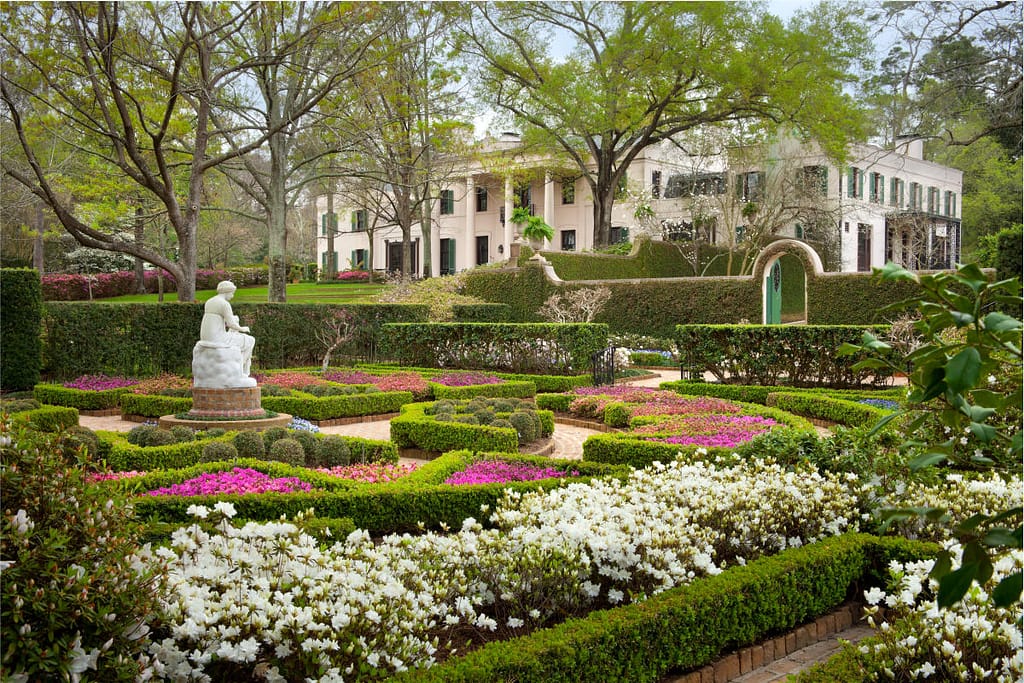Houston, known for its dynamic growth, is also home to a number of well-preserved historical homes and mansions that tell the story of the city’s evolution. These homes reflect architectural styles from different eras, showcasing the wealth, taste, and ambition of the people who built them. Each house has its own narrative, blending history with charm and adding to Houston’s cultural fabric.
The Bayou Bend Collection and Gardens
Nestled in the River Oaks neighborhood, the Bayou Bend Collection and Gardens stands as one of Houston’s architectural jewels. Built in 1928, this mansion was originally the home of Ima Hogg, a prominent philanthropist and arts patron. The house, designed in a blend of Georgian and Colonial Revival styles, is now part of the Museum of Fine Arts, Houston.

The surrounding gardens are just as impressive, featuring lush landscapes and winding paths. Today, visitors can explore the Bayou Bend museum, which houses an impressive collection of American decorative arts from the colonial period to the 19th century.
The Nichols-Rice-Cherry House
Built in 1850, the Nichols-Rice-Cherry House is among the oldest surviving homes in Houston. This Greek Revival-style house has a fascinating backstory, having been moved several times across the city to preserve it. It was once home to William Marsh Rice, the founder of Rice University.

The house’s simplicity contrasts with the grandeur of later mansions, but its historical significance lies in its connection to the city’s early leaders. Today, it serves as an example of Houston’s commitment to preserving its architectural history.

The John F. Staub Homes in River Oaks
Architect John F. Staub played a pivotal role in shaping Houston’s architectural landscape, particularly in the prestigious River Oaks neighborhood. His designs, heavily influenced by European styles, gave rise to some of the city’s most beautiful homes. Staub’s houses are known for their elegance, balance, and meticulous attention to detail.
One of his masterpieces is the Waldemar-George House, a fine example of French Colonial architecture. These homes continue to be sought after by buyers who appreciate their timeless appeal and craftsmanship.

The Bishop’s Palace in Galveston
Although technically located in Galveston, just a short drive from Houston, the Bishop’s Palace deserves mention for its architectural beauty and historical relevance. Built in 1892, the house combines elements of Victorian and Gothic styles, with intricate woodwork and stained glass.
Originally constructed as a private residence, the house later became the residence of the bishop of the Galveston-Houston Diocese. It now operates as a museum, allowing visitors to explore the opulent interiors that reflect the grandeur of a bygone era.

The Julia Ideson Building
Located downtown, the Julia Ideson Building is a unique blend of Spanish Renaissance architecture. Originally part of the Houston Public Library system, this historic building, completed in 1926, remains one of the city’s most beloved landmarks. Its interiors feature marble columns, murals, and arched windows, offering a glimpse into Houston’s architectural past.
In addition to serving as a library, the building also hosts exhibits and events, making it a cultural hub in the heart of the city.

Preservation and the Future of Houston’s Historic Homes
Houston’s commitment to preserving these architectural treasures is evident in the work of local historical societies and museums. However, the city’s rapid development presents challenges. Efforts are underway to protect these homes and mansions from being overshadowed by new construction.
Many of these homes are now museums or part of cultural institutions, offering the public a chance to connect with the past. Preservation initiatives focus not only on maintaining the structures but also on telling the stories of the people who lived there.